An Interview with Zoe Gardner
By Ann Armbrecht (photo: Stinging Nettle)
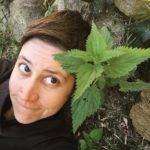
Zoe Gardner is a botanist, potter, and a self-proclaimed herb nerd with over 20 years of experience working with medicinal plants. See below for full bio.
I first met Zoe Gardner when she came to the International Herb Symposium in 2015 to present on regulatory compliance, good manufacturing practices, and how herbalists used to making remedies in their kitchens could navigate the world of the FDA. We corresponded occasionally after that. She wrote the GMP/FDA overview for the SHP website, but we weren’t in that close contact.
And so I was surprised to suddenly begin seeing stunning images of mugs imprinted with nettles, motherwort, and yarrow showing up on my Instagram feed under the name @herbnerdzoe. I’d heard Zoe had left Traditional Medicinals but I had no idea she had moved back east and was focusing full time on pottery. I was intrigued not just by how she made her pottery, but by how she navigated the worlds of science and spirit in her work.
We sat down on a blanket behind her booth (which had a steady flow of customers for the entire conference) to talk at the 2019 International Herb Symposium.
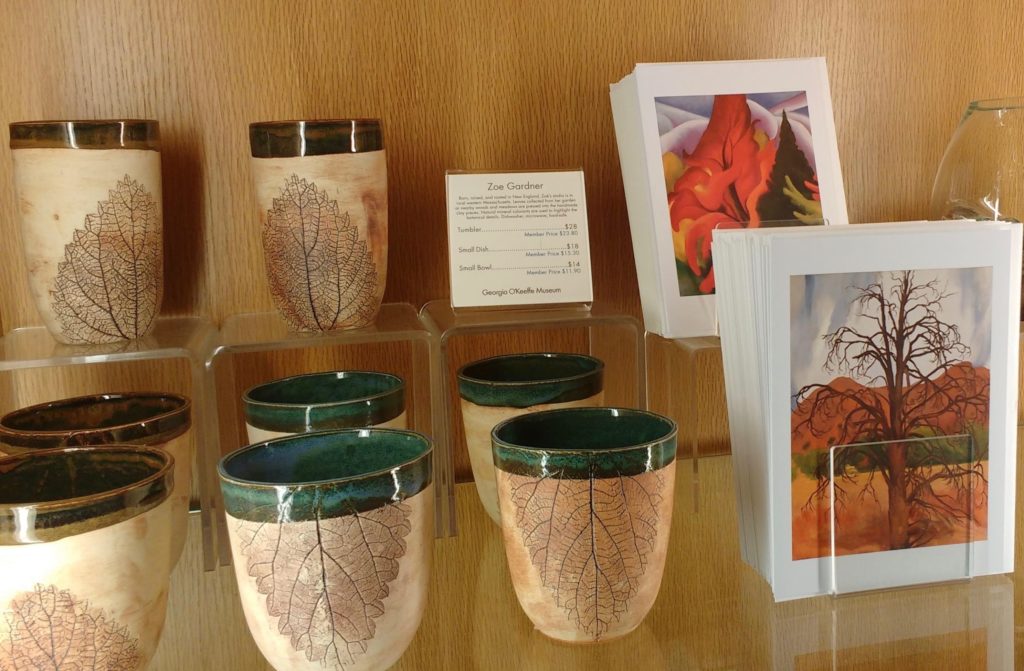
Photo by Melissa Jenski.
Before I could ask a question, Zoe started right in.
“You Need to Know This!”
Zoe: So two nights after you asked about doing an interview I had a dream that was very clear–my dreams are not usually clear! I had a memory of picking plants and then I was talking to some people. I told them that when you work directly with plants, when you harvest from them, you must realize that they are beings that are going to be missing parts of themselves. It is like you are taking something from somebody. And then I woke up.
And so, I guess that’s what I’m learning this year. I’m picking the leaves and I’m learning to say thank you. I realize how that’s a big missing piece in commerce. We just take this stuff and don’t say thank you. We order 10 tons of nettles without acknowledging that they are living beings. That’s what came up to me from that dream. That was fascinating. And I was very emphatic in the dream. I was like, ‘People, you need to know this!’
The Limits of Science
Ann: What a wonderful dream! Can you talk a little bit about your journey to realization, from science to a recognition of what many trained in science would dismiss as crazy? Because in many ways it is a journey we all need to make, no?
Zoe: In my family our religion was science. I had a devout atheist scientific upbringing that acknowledged a love for nature. As a kid, we had some woods behind the house, I’d go back there and play with the plants. I got to know the plants through play, and when I learned that plants could be used as medicine, my brain exploded a little bit. I couldn’t wrap my mind around it fully, but I was fascinated.
So, I began to study biology and science and plants and followed that track along through college with a focus on medicinal plants. As I graduated, there was a position that opened-up at UMass working for professor, Lyle Craker, a medicinal plant specialist, and I worked for him for 10 years, ended-up doing my master’s degree there. And I finished my PhD this past semester, focusing on medicinal plant quality and safety.
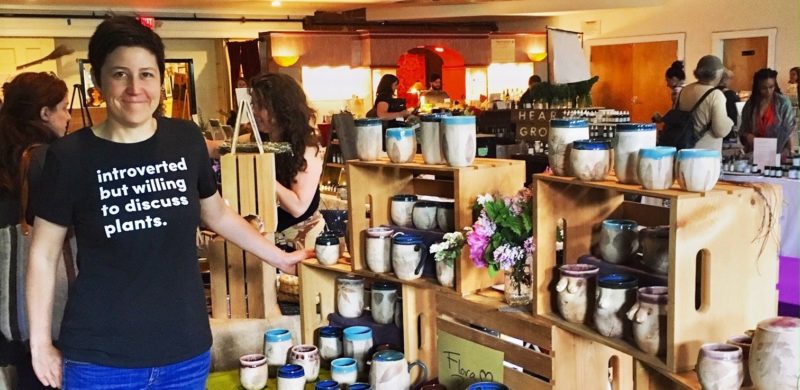
Zoe Gardner with her pottery. Photo by Melissa Jenski.
I followed that scientific path and worked at Traditional Medicinals for a number of years. Last spring I Ieft that job to take a break, to have a sabbatical from the technical work, and to try out this pottery dream. I’ve been exploring the spirit side, hanging out more with the plants, and being a little open, more open to everything than I had been, because, I had always taken science as the way to relate. And I also explored science deeply enough to see how much it can’t explain yet, how limited it is.
I recently started reflecting on how scientists say that people learned the properties of medicinal plants. Scientists tend to cling to the idea that it was all trial and error, people trying plants and seeing what happened. But just about every indigenous plant medicine person that I’ve heard from says they communicate with the plants in one way or another—that the plants disclose their uses to people. Science is so patronizing in its dismissal of what so many healers are saying. I appreciate what Robin Wall Kimmerer has said, that there aren’t any scientific studies that show that plants or animals are dumber than we think. It’s just the opposite. That reflection got me very curious and helped me realize how much more there is to learn.
Research and Development
Ann: Can you talk some about your work in R & D. What was your specific job at TM?
Zoe: At TM I did product development, formulation, some of the regulatory compliance, making sure that the claims were accurate and compliant. I worked with the marketing department to help make sure that our packaging and social media were accurate and legally compliant.
Ann: You were working with the plants in a particular way, right?
Zoe: Yeah, but never touching them. I went on three sourcing trips, and those were the best part of my time there. You know, getting out in the field. I did interface with the QC lab, working on product and ingredient specifications with them, figuring out what testing we were going to do for new products. But a lot of my work at TM was product development. Checking the formulation, and then shepherding the new product from formula to package. Lots of work about the plants, but hardly every with the plants.
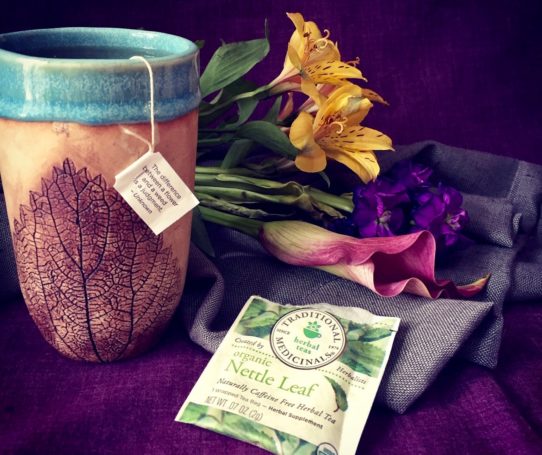
Photo by Zoe Gardner.
The work at TM also involved product substantiation. Looking into whether there was enough science and/or traditional information that we could make a good case for that in a substantiation file. Very much on the technical side of things.
I started back into pottery there. I’ve kept a garden for most of my life. When I was in Sebastopol, I didn’t have one, and I realized I needed some dirt. I needed some plants. I was missing having time with them. So I started back into pottery, which I had learned many years before, and almost right away I started using plants in the pottery. If it hadn’t been for working at TM, I don’t think I would have gotten this far. I would bring in the pottery that I made at the local community studio to TM and people from the lab got so excited to see plants on pottery. It was a very sweet, supportive environment to get started and it kept me going.
Learning to See
Ann: Can you describe your process?
Zoe: The most important thing I’ve come to see is that I am working together with the plants. Customers often ask if I use real leaves or if I draw the leaves on. I don’t have enough patience to create the detail that the plants do. Plants grow the veins. They have the patience and the need to do that. I help the leaves to be seen, and it’s been amazing to get to know the plants in a different way, to focus on their beauty.
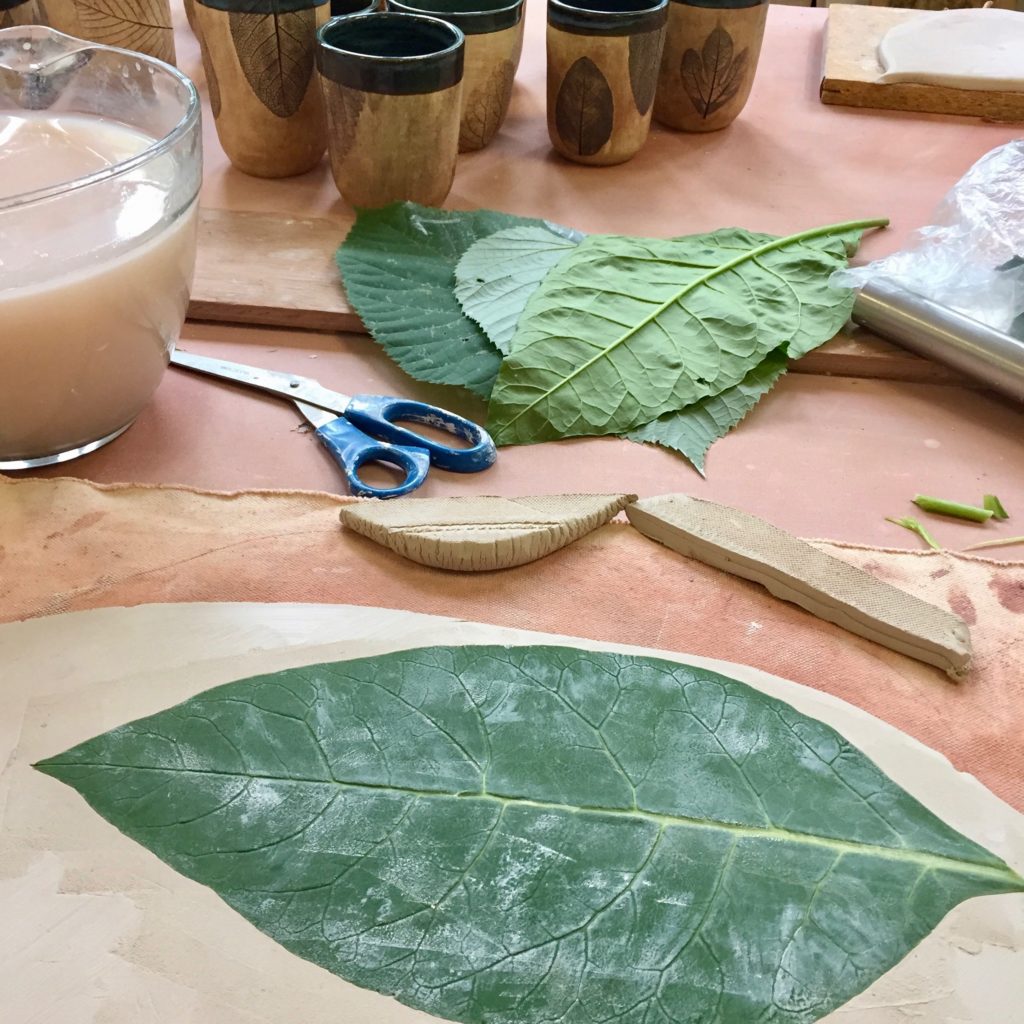
The process of making pottery with medicinal plants, photo by Zoe Gardner.
I watch mugwort over a season. The leaves change so much. Right now, they’re really dense, typical leaves and then, later in the season, the leaves on the flowering stalk will look way different, like leaves with long fingers. Working with nettles, I see how the leaves from the northern California coast are huge and tough from the salt air. The leaves from the nettles in my sunny front yard in MA are much smaller and thinner, and again very different from the ones that are in the shady backyard. It’s a treat to get to know plants in this way.
Ann: How do you decide which plants to use?
Zoe: I started with figuring out what works. Nettles work really well. Motherwort is delightful. A lot of the mint family leaves are reliably nice. Lots of other plants, like raspberry leaf or yarrow, work well too. I experiment with different leaves and then it’s a combination of what works well and what people love.
It’s been helpful to get some feedback in terms of the practical commercial end of things through surveys on social media.
Listening
If I listen, which I’m learning to do, the plants are pretty good at helping out with ideas. I think it’s like meditation, like you don’t know when you’re really doing it when you are just beginning. I don’t know if I’m really hearing the plants or if it just feels like I’m hearing them. But the more I give over to them, the better.
Listening to more indigenous voices has been very important. There is a podcast, All My Relations, where they are talk a lot about relationality and I am slowly reading my way through Braiding Sweetgrass by Robin Wall Kimmerer. She is also talking about that relationality with plants and other beings. I’m listening to that message, taking that in a little bit more, and trying to incorporate that into how I work with plants.
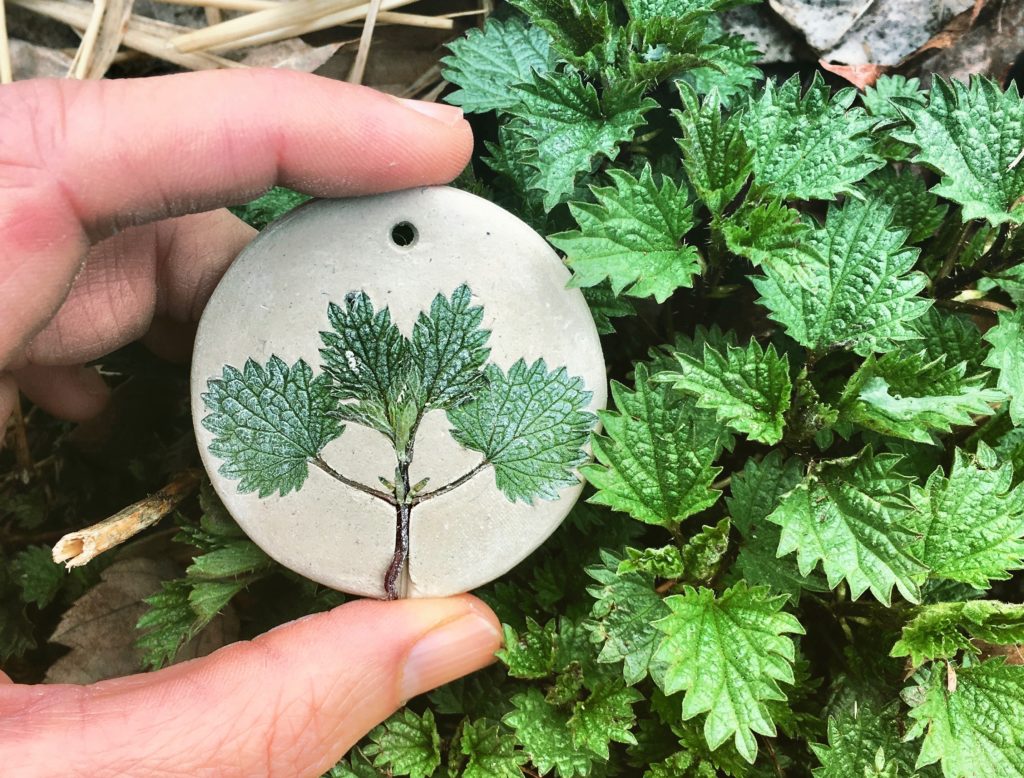
Pendents made with nettles, by Zoe Gardner
Kimmerer talks about a reciprocated love between humans, the earth, and other beings. That inspired me to get a stamp that I use on the back of the pendants I make that says ‘you are loved.’ I created those to work with the idea that there’s a reciprocal love between people and plants. I’m trying to get that message out and help people feel that and remember that. I’m still working on the back and forth of it myself, but I’m starting by acknowledging the love.
Reciprocity and Beauty
Ann: The chapter, ‘The Language of Animacy’ in Braiding Sweetgrass, made me think a lot about how to let the aliveness that exists in our relationships with plants guide how we interact with them as medicine, treating the plants as a living entity, not just as objects of commerce that will do something for our health.
Zoe: Yes. We need to acknowledge that and feel it more. I’ve been appreciating something that herbalist, Kat Maier said, that it’s really rude to meet someone and say, “Hi, what you are good for?” The same thing goes for plants. It is important to recognize that there’s much more to plants than their medicinal effects on humans.
Ann: Feeling it seems to be the key, no? Everybody seems to acknowledge it.
Zoe: It is important to acknowledge that trees are important for oxygen and carbon sequestration and things like that. But there’s so much more there. It is powerful for the people who feel it. So, if we can do more of that, take care of plants and recognize how plants are part of the culture, we’ll be far better off. One of the All My Relations podcast talks about that – indigenous practices of tending wild food and medicine plants. The caretaking and reciprocity that happens.
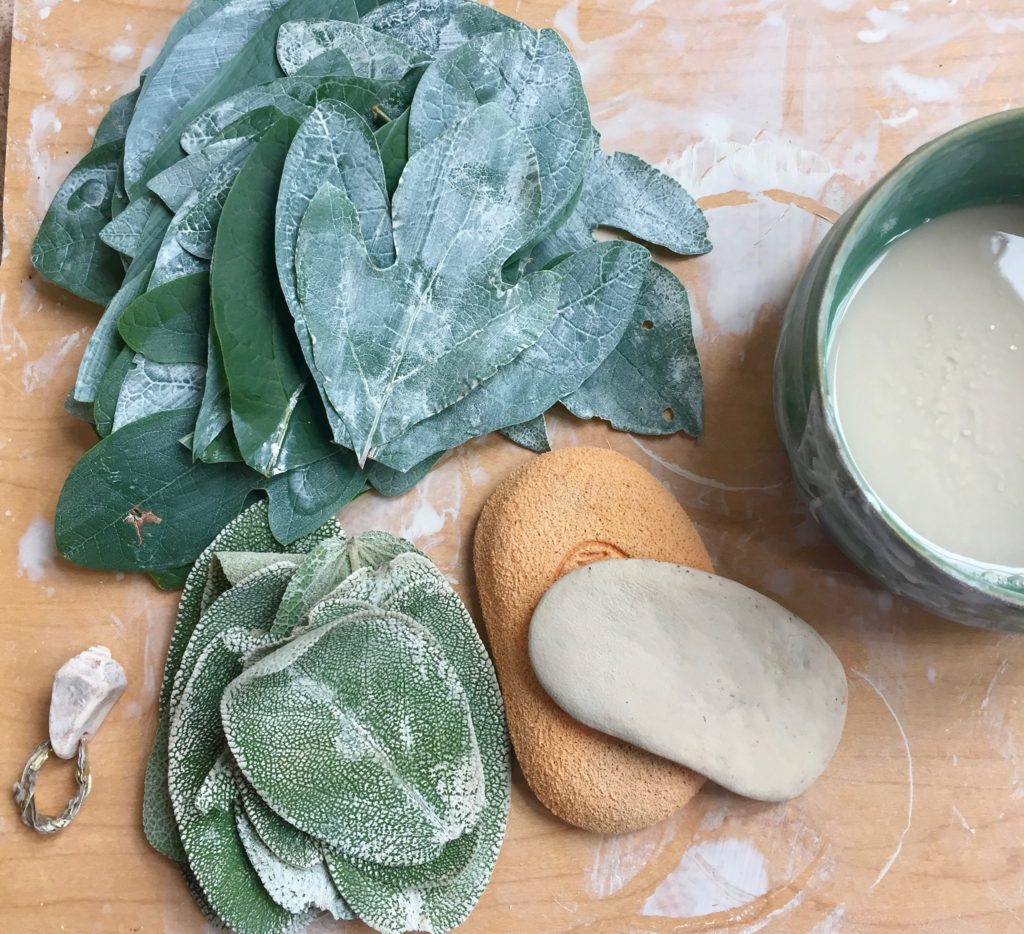
The process of making pottery with medicinal plants, photo by Zoe Gardner.
Ann: That makes me wonder how you go about doing the work itself? How are you in yourself when you find the plants and make the pots?
Zoe: The TM work is all upstairs in the brain. The regulatory stuff requires making sure everything is technically accurate, that there is evidence to support every statement, that the words are all correct, that the dosage numbers line up.
One of the things that I appreciated about working at TM is that there were a lot of plant people there, folks who understood that plants were far more than their chemical composition. All of the herbalists who worked there were drawn to herbalism by a deep love of plants. In daily business we didn’t talk about the spiritual side of plants, but we knew we had that connection in common. Our jobs were technical, but our hearts were much more invested than in other technical jobs.
So that was the TM side. And now there’s the pottery and the plants.
Ann: And?
Medicine in Beauty
Zoe: It’s much more emotional with the plants. We have battles at home about how many nettles I get to keep in the yard. I tell my partner, “No, no, you can’t weed whack those because I need them for my pottery.” And he asks, “But how many do you need? We already have two huge patches!” We have way more nettles that I could possibly use, and I get sad every time we cut down the nettles, so much beauty in each leaf, and I get sad that that beauty won’t get fully appreciated.
When I’m hiking, I’m looking at plants in a different way. I’m looking at leaves for their beauty, studying the veins for their patterns and texture. Because flowers get all the credit, right? The color and the smell and all that. They work okay in pottery. But because they can’t bring the color and because they’re so delicate, it usually is not very exciting to see the flowers unless people can fill it in with their minds and their hearts.
I am really focusing on the leaves, looking at them, feeling their texture and getting a sense of how they will print into clay, watching how they grow and change over the growing season.
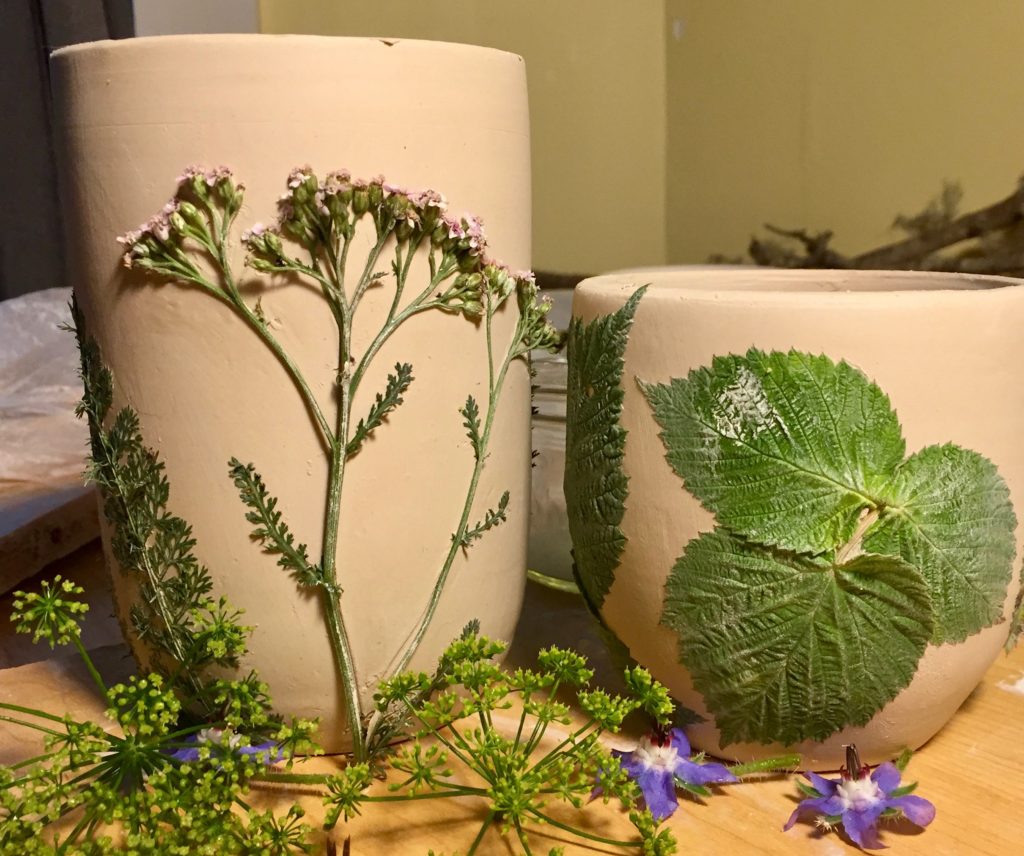
photo by Zoe Gardner
Ann: It makes me think about plants and the different kinds of medicine they offer. What do you think about that?
Zoe: There’s medicine in beauty, and especially when people are moved by the beauty of plants and experience moments of awe or wonder.
Ann: I keep thinking about your dream. There is that relationality, there are herbs and commerce, and then there’s how we ingest them for chemical constituents and our own healing. It feels what you are talking about is a different way of being with them. What is the medicine in this way of working with these medicine plants, what is the healing?
Same Plants, Different Medicine
Zoe: I’ve been helping out a small company with some regulatory paperwork. And using some of their products at the same time. It’s so interesting to experience. Traditional Medicinals does an amazing job as a big company making herbal medicine and making it widely available. And it’s really different from a company that is growing herbs carefully in their garden, bringing them inside making the medicine right there and tending to it the whole way, saying prayers and giving thanks.
Same plants, different medicine. Two products can be made from nettles. One with nettles wildcrafted in the beautiful Bosnian countryside, dried and shipped to Germany, where it’s run through a mill, tested, and then brought over to California. It’s tested again to make sure it meets all the quality criteria. And so that’s one form of good medicine. Then you have the nettles that have been carefully tended in a garden and gathered with that heart intention, and exchange of words and whatever else. It’s just different.
Zoe paused to add, “My science brain is about to riot back here. It’s okay,” she said, laughing.
And my scientific side says it’s not different. But my experience is that it’s, it is different. And again, both are good medicine, and I use both regularly for myself. So that has been interesting to interact with.
What Science Can’t Explain
This year, I’ve been thinking a lot about what science can’t explain yet. There is so much, right? There is what we personally experience and know, that makes me curious. And then there is some of the metaphysical stuff within the herb world that I’m not on board with necessarily. And I don’t know if there’s just not enough science to explain it yet. Or it’s really not there. Is it people with good intentions, but it’s not necessarily good medicine? Or is it good medicine for the right people? My science side is very skeptical. There are so many well-intentioned people. And it’s hard to know sometimes what’s useful and what’s not. So it’s sorting that out. I’m trying to maintain an open mind and heart, and still have some kind of assessment tool in my mind.
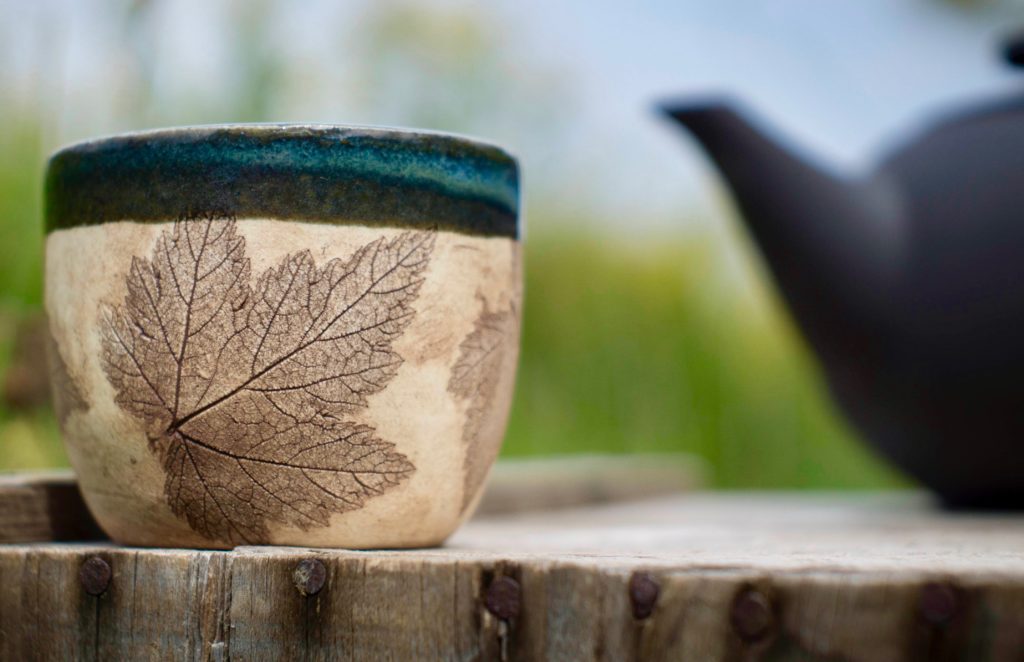
Photo by Zoe Gardner.
Ann: It makes me think of an article by Harish Naraindas [1] on the formulation of Ayurvedic medicine that I used in a class I recently taught on Asian Medical Systems at Dartmouth College. The author talked about the alchemy of the process of formulating the medicines, specifically the logic of yogam or union of a formulation that was more complex than simply combining plants and even more complex than the idea of synnergy. It’s hard to explain but it was an example of the kind of rigorous science that exists within the tradition, not from applying western principles. It was rigorous and it was spiritual. Not in a new age flakey kind of way.
Zoe: Yes, western herbalism, especially the aspect that I’ve been interfacing with on technical work, has been getting filtered so much through a western scientific point of view. So much of the information focuses on the actions, chemistry, and technical aspects. Many western herbalists understand and teach about the spiritual side of plants, but this is not built into the structure of western herbalism. A person can easily study western herbalism and never learn about the spirit of plants or people. Most other healing systems recognize a strong spiritual aspect to healing. And so, it’s fairly clear that that’s missing.
I had the chance to go to Shanghai to the TCM museum there which was amazing. And you know, I think we have some sense in here in the US that acupuncture is useful and has a long tradition, but we have no understanding of the rigor with which it’s been studied. For example, little machines at the museum helped the medical massage students make sure their massage strokes were correct – the pressure, that direction, the depth, are all quantifiable and assessable.
They had a big statue from a thousand years ago, a full-size human with the meridians and points on them. The inside of the statue was hollow and they would fill it with a wax layer and then with water. Students would do the acupuncture needling and then the teachers would come through and pull the needles out. If any if water came out of any of them they knew they had needled too far.
Ann: That reminds me of one of my favorite parts of all our interviews for Numen, when the late Dr. Bill Mitchell said,
“If we examine the leaf of a plant, if we get down closer and closer, we get a cell. And then we get an atom. We get closer and closer and eventually we come down to things we don’t understand. We ultimately come down to mystery when we look close enough. The closer you look, the more magical and magnificent and mysterious something is.
It’s our problem that we don’t look close enough, not the problem of the universe. It’s not the problem of science and chemistry that we don’t look close enough. But when we do look close enough and we come to appreciate what the chemistry symbolizes, what in fact it is, then we are always brought down into mystery.”
Which to me seems to be a good place to end this conversation. Thank you so much, Zoe!
Zoe Gardner is a botanist, potter, and a self-proclaimed herb nerd with over 20 years of experience working with medicinal plants. A specialist in the quality and safety of medicinal plants, she is the author of the 2nd edition of the American Herbal Products Association Botanical Safety Handbook, a reference text on the safety of over 500 medicinal plants. She earned a Ph.D. in plant science from the University of Massachusetts Amherst, and helped found the Medicinal Plant Program there. Zoë went on to oversee product development and product safety at Traditional Medicinals. She now splits her time between working as a research consultant to herbal companies and creating botanical pottery. You can find more about her pottery at www.florapottery.com You can also find her on Instagram @herbnerbzoe.
References Cited
- Naraindas, Harish. “Of Shastric ‘Yogams’ and Polyherbals: Exogenous Logics and the Creolisation of the Contemporary Ayurvedic Formulary,” Asian Medicine 9(2014):12-48.

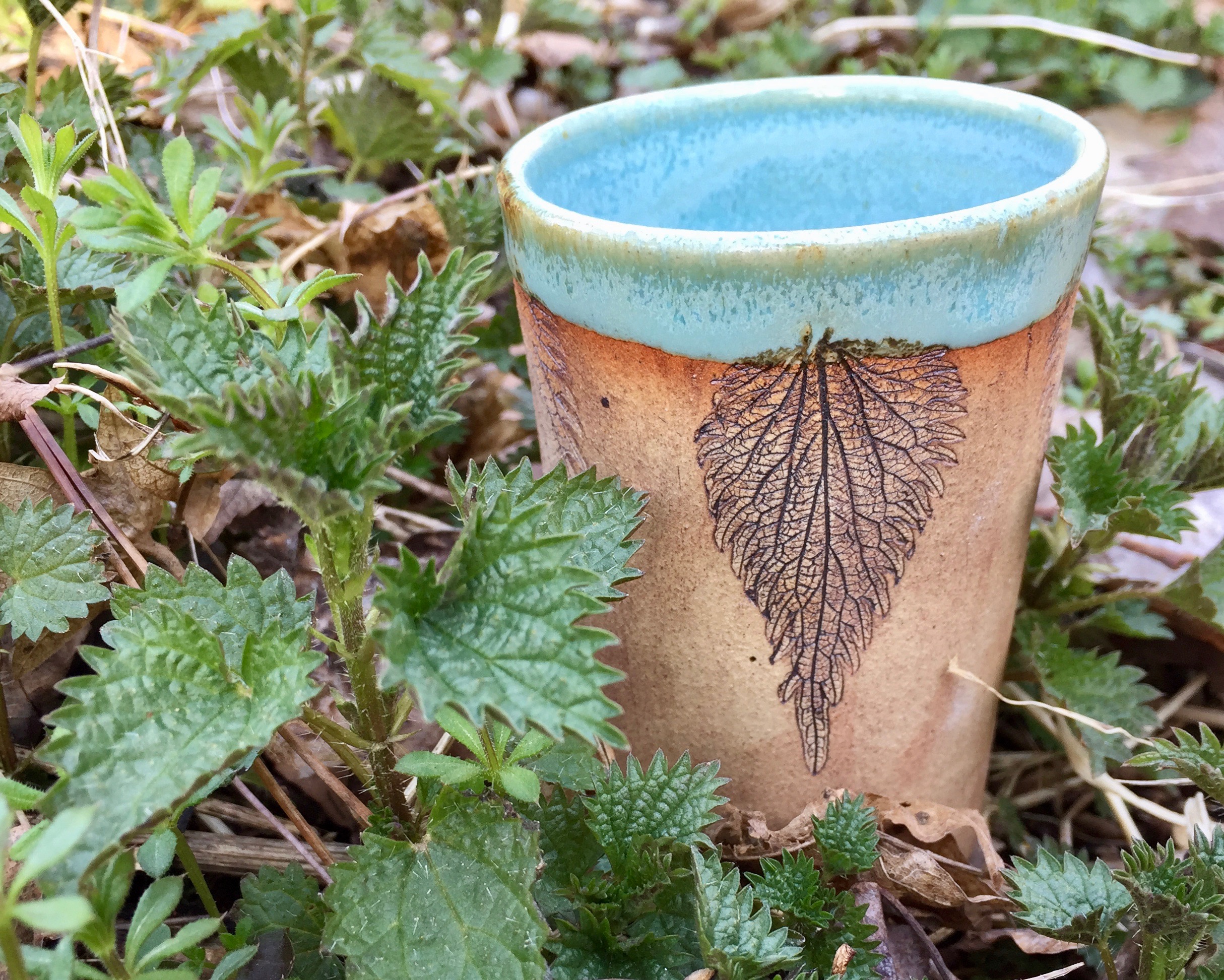
Comments